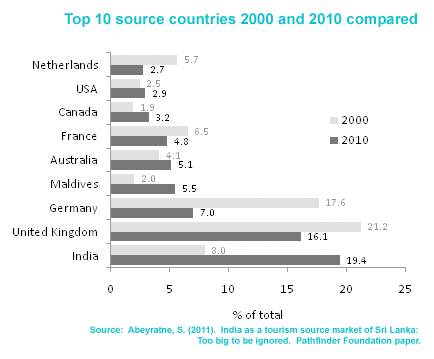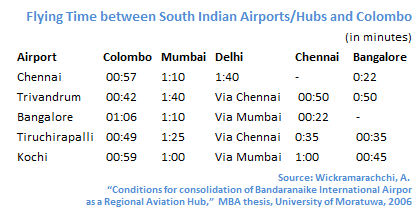A large number of Indians come to Sri Lanka now. India has been the largest source of tourists since the ceasefire. How can more be attracted?

Patel points
Indians with money to spend on tourism are not very different from Sri Lankans with money to spend on tourism. It may appear that they want new experiences, but in actual fact, they want things to talk about with their friends upon return. "Do you know what we saw on the way to the Statue of Liberty?" "The Eiffel Tower is so fantastic when it’s lighted up." And so on.
The whole business is still very new, the exchange controls being relaxed only recently and the high growth rates only beginning to be felt even more recently. So photographs are important. Not just any photographs, but those of Patel points: those taken at locations that the viewer can instantly identify. The pyramids of Giza, Tiananmen Square, the Merlion in Singapore, London Bridge, the mermaid in Copenhagen. Without pictures taken against these backdrops, how could one tell (and be impressed), especially if one has yet to make the trip? Without the Patel points the desired effects will not be achieved.
Bangkok is the new, new thing in India these days. Bangkok has many Patel points. The Grand Palace. Wat Pho. The Chao Phraya river.
Does Colombo? Kandy? The only place that comes close for Indians is Bentota, pronounced with hard Ts. Not for the pictures, but for the name. For many Indians, a trip to Sri Lanka would not be complete without Bentota. Like we would not have really visited India, unless we took a Patel shot of ourselves with the Taj Mahal in the background.
So the way more middle-class Indians can be attracted to Sri Lanka is to create Patel points. How?
But this cannot be done in months. It’s a long term project.
Convention tourism
It’s odd that an industry so dependent on selling, uses a terrible acronym to describe convention tourism. MICE. Meetings, incentives, conventions, exhibitions. Comprehensive, yes. But attractive as an acronym? Definitely not.
The whole point in MICE tourism is that someone else makes the decision. In many cases, someone else pays part of the bill too: the company pays the airfare and the hotel bill for example. This is why MICE is good. When people are brought to a country and have part of their costs met, they are generally in a good mood. They will spend money.
MICE decision makers are few. They are easier to persuade.
Long before the Tourist Authority designated Negombo as the designated location for MICE, my organization brought meetings to Negombo. The meetings rooms were inadequate, but anything could be endured to avoid the grief caused by the road from the airport to Colombo.
The conventions we organized then led to Board meetings of South India based companies being organized here. Once familiarity was created, the economic advantages were seen. Colombo is closer to major South Indian cities than Delhi or Mumbai.

The conventions as well as the board meetings then led to some of the participants going off on additional tours to Kandy, Yala and elsewhere. Once the conventioneer is in the country, everything else is incremental.
So, this is the short-term solution. Give incentives for MICE tourism. Build familiarity.
What has to be done
How to create Patel points?
Invite Bollywood, Kollywood and whatever other woods they have to come and make films here. The IIFA investment was large, but its returns will be come with sustained engagement with Bollywood and the other assorted Woods. If we can get a few hit movies with identifiable Sri Lankan backdrops made, we will be well on the way to creating Patel points. Once that is done, the middle-class Indians will come in droves to Sri Lanka.
This is not easy as was found with the IIFA awards. We are not the only ones after the Indian tourist dollar. Bollywood is getting invitations and freebies from all over the world. They negotiate hard. Some freebies will have to be given but there is no better way to create Patel points. Patel points exist in the minds of the middle-class Indians. The best way to create them is through film and TV.
MICE is easier. But the confusion about visas has to be resolved. And quickly. When we organized a major event in December 2009 that brought in people from 30+ countries, we found tremendous confusion around the visas for invitees. Were they tourists, and thus entitled to visa on arrival at the airport? According to the World Tourism Organization (1995), international tourists are temporary visitors to a country staying more than a day for leisure, business and other purposes not related to the exercise of an activity remunerated from within the place visited.
We argued our visitors fit the definition, and furthermore we had Tourist Authority blessing under the MICE program. This is a kind of tourism, we said, MICE tourism. But we notified the Controller of who was coming and submitted the passport details, just in case.
The keynote speaker was from New Delhi. Independently of us, his office had inquired about a visa from the High Commission and had been told it was not necessary. On arrival at the airport, he stated he was here for a conference. He was told he should have obtained a visa prior to arrival. All ended well and he was allowed to enter, perhaps because of the precautions we had taken.
I reported the problem to our High Commissioner. He said his consular officials were wrong to have told my colleague he did not need a visa. Confusion at all levels in different ministries.
The conventional expensive and time-consuming method of issuing non-tourist visas will kill the MICE option. Something simple, even if it involves paying a fee at the airport, is essential. And getting officials in the consulates and airport and the Department of Immigration and Emigration to say the same thing is as important.
Rohan Samarajiva heads LirneAsia, a regional think tank. He was also a former telecoms regulator in Sri Lanka. To read previous columns go to LBOs main navigation panel and click on the 'Choices' category.
